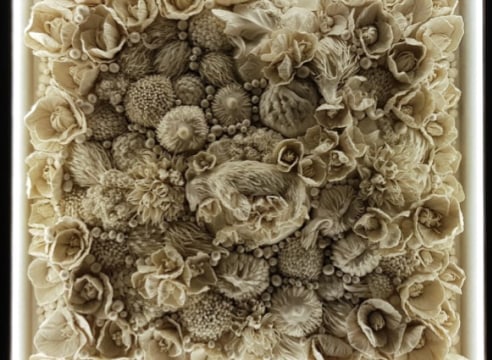
Dubai, UAE – Leila Heller Gallery is pleased to feature Turkish artist Melis Buyruk’s new collection of works, titled ‘The Bloom Room’, opening on 26th April 2023, in its pop-up kiosk across from the gallery’s permanent space at Warehouse 87 in Alserkal Avenue.
Since the 18th century, when modern man raised above the earth in order to subjugate everything around him, nature and all its elements became raw-material for the industrial progress of humanity. Due to the hierarchical diversion between nature and culture, plants and animals lost their mystical and spiritual meanings and became the platform for the technological development of the Homo Faber. While he progressed, he became unbeatable, indeed, unstoppable in the evolutionary race. Though, this departure from mankind’s roots also alienated our relation with nature.
Melis Buyruk reviews our relation with nature by depicting creatures on a strange ground where pieces of plants and animals are merged with human body parts. Her ontological analysis of man’s role in the circle of life refers to various fields from philosophy to psychology and socio-politics. It underlines that instead of mechanical categorization and separation, a holistic world view is needed, and entropy must be embraced as a positive energy in the never-ending flux of life. We know that new forms of existence cause now forms of creatures. This means that we must be open to new forms of living, where empathy, collaboration and coexistence become fundamental mentors of change.
The quasi-naturalism of her porcelain works gets opposed by her collage-like approach and fragmental notion of figure. The illusionistic aesthetic, which on the first look make the works appear as realistic, opens-up links to surreal dreams and nightmares. Out of the clash of realism and surrealism appears a distortion effect that make the pieces highly attractive. At the same time, an uncanny but appealing atmosphere surrounds the works, which results from her dialectical play with representing and distorting, as well as mirroring and creating reality. As a result, the spectator permanently shifts between recognizing and misconceiving as well as knowing and not-knowing the presented elements in her sculptures.
This dynamic perception process makes new understandings of our natural world possible. It means the first step towards alternative insights in the way we live with the environment around us, and could become the beginning of personal change. Clashing its fine and delicate character with references to flora, fauna and anthropology in order to create hybrid in-between-creatures, an alienation effect occurs, which brings the spectator to rethink his own relationship with nature.
Melis Buyruk’s game of illusion and distortion functions like a window into another reality, where alternative conceptions of flora and fauna exist. It is a world, in which humans and animals live in harmony and unity. Connected and mingled with each other, they have created forms of collaboration, coexistence and real community, terms that we need to embrace now more than ever in order to ensure our human survival.
Written by Prof. Dr. Marcus Graf
ABOUT THE ARTIST
Melis Buyruk is a Turkish artist born in Gölcü k in 1984. Her large-scale floral ceramic sculptures depart from contained, categorical forms of pottery, and celebrates the traditionally feminized discipline. Melis identifies and subtly blends patterns of vegetation and the natural world, creating porcelain flower fields. They are disorienting, as they evoke both artificiality and illusion in a play on logic. While strikingly realistic and incredibly meticulous, the porcelain flowers are unfeasibly monochrome, hybrid, and eerily level, suggesting an alien environment. Drawn to the poetic fragility of porcelain, and the physical engagement it required, Buyruk became a specialist in the craft at the Faculty of Fine Arts at Selçuk University.